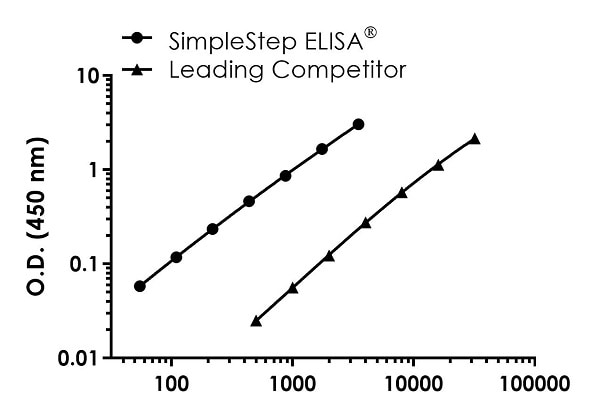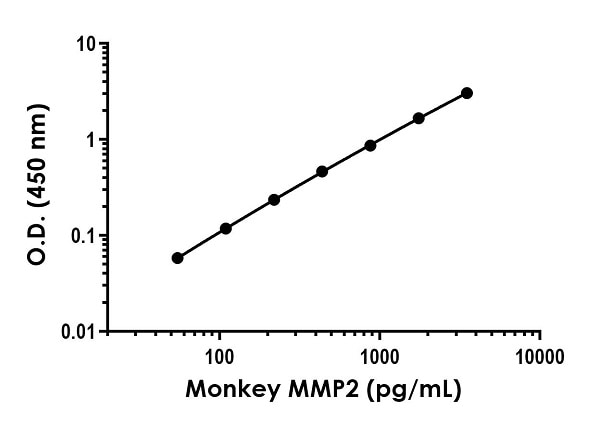Monkey MMP2 ELISA Kit (ab269561)
Key features and details
- One-wash 90 minute protocol
- Sensitivity: 17 pg/ml
- Range: 54.69 pg/ml - 3500 pg/ml
- Sample type: Cell culture supernatant, Cit plasma, EDTA Plasma, Hep Plasma, Serum
- Detection method: Colorimetric
- Assay type: Sandwich (quantitative)
- Reacts with: Monkey
Overview
-
Product name
Monkey MMP2 ELISA Kit
See all MMP2 kits -
Detection method
Colorimetric -
Precision
Intra-assay Sample n Mean SD CV% Serum 3 1.3% Inter-assay Sample n Mean SD CV% Serum 8 7.8% -
Sample type
Cell culture supernatant, Serum, Hep Plasma, EDTA Plasma, Cit plasma -
Assay type
Sandwich (quantitative) -
Sensitivity
17 pg/ml -
Range
54.69 pg/ml - 3500 pg/ml -
Recovery
Sample specific recovery Sample type Average % Range Cell culture supernatant 91 87% - 93% Serum 109 108% - 110% Hep Plasma 98 87% - 104% EDTA Plasma 110 106% - 117% Cit plasma 97 92% - 105% -
Assay time
1h 30m -
Assay duration
One step assay -
Species reactivity
Reacts with: Monkey -
Product overview
Monkey MMP2 ELISA Kit (ab269561) is a single-wash 90 min sandwich ELISA designed for the quantitative measurement of MMP2 protein in cell culture supernatant, edta plasma, hep plasma, serum, and cit plasma. It uses our proprietary SimpleStep ELISA® technology. Quantitate Monkey MMP2 with 17 pg/ml sensitivity.
SimpleStep ELISA® technology employs capture antibodies conjugated to an affinity tag that is recognized by the monoclonal antibody used to coat our SimpleStep ELISA® plates. This approach to sandwich ELISA allows the formation of the antibody-analyte sandwich complex in a single step, significantly reducing assay time. See the SimpleStep ELISA® protocol summary in the image section for further details. Our SimpleStep ELISA® technology provides several benefits:
- Single-wash protocol reduces assay time to 90 minutes or less
- High sensitivity, specificity and reproducibility from superior antibodies
- Fully validated in biological samples
- 96-wells plate breakable into 12 x 8 wells stripsA 384-well SimpleStep ELISA® microplate (ab203359) is available to use as an alternative to the 96-well microplate provided with SimpleStep ELISA® kits.
-
Notes
Monkey MMP2 (matrix metalloproteinase 2) is a 72 kD protein matrix metalloproteinases (MMPs) family member, consisting of 24 known human zinc proteases. MMPs essential role is breaking down components of the extracellular matrix. MMP substrates include cytokines, chemokines, growth factors and binding proteins, cell adhesion molecules, and other proteinases. Most MMPs share common structural motifs including a pro-peptide domain, a catalytic domain, a hinge region, and a hemopexin-like domain. MMPs are synthesized as pro-enzymes and secreted before conversion to their active form. MMP activity is regulated on several levels including transcription, pro-enzyme activation, or by their endogenous inhibitors, tissue inhibitors of metalloproteinases. Monkey MMP2 shares 99.7. 96.7. 96.4 and 96.2 percent sequence homology with human, mouse, rat and cow, respectively.
-
Platform
Pre-coated microplate (12 x 8 well strips)
Properties
-
Storage instructions
Store at +4°C. Please refer to protocols. -
Components 1 x 96 tests 10X Monkey MMP2 Capture Antibody 1 x 600µl 10X Monkey MMP2 Detector Antibody 1 x 600µl 10X Wash Buffer PT (ab206977) 1 x 20ml Antibody Diluent 5BR 1 x 6ml Monkey MMP2 Lyophilized Recombinant Protein 2 vials Plate Seals 1 unit Sample Diluent NS (ab193972) 1 x 50ml SimpleStep Pre-Coated 96-Well Microplate (ab206978) 1 unit Stop Solution 1 x 12ml TMB Development Solution 1 x 12ml -
Research areas
-
Function
Ubiquitinous metalloproteinase that is involved in diverse functions such as remodeling of the vasculature, angiogenesis, tissue repair, tumor invasion, inflammation, and atherosclerotic plaque rupture. As well as degrading extracellular matrix proteins, can also act on several nonmatrix proteins such as big endothelial 1 and beta-type CGRP promoting vasoconstriction. Also cleaves KISS at a Gly-
-Leu bond. Appears to have a role in myocardial cell death pathways. Contributes to myocardial oxidative stress by regulating the activity of GSK3beta. Cleaves GSK3beta in vitro.
PEX, the C-terminal non-catalytic fragment of MMP2, posseses anti-angiogenic and anti-tumor properties and inhibits cell migration and cell adhesion to FGF2 and vitronectin. Ligand for integrinv/beta3 on the surface of blood vessels. -
Tissue specificity
Produced by normal skin fibroblasts. PEX is expressed in a number of tumors including gliomas, breast and prostate. -
Involvement in disease
Defects in MMP2 are the cause of Torg-Winchester syndrome (TWS) [MIM:259600]; also known as multicentric osteolysis nodulosis and arthropathy (MONA). TWS is an autosomal recessive osteolysis syndrome. It is severe with generalized osteolysis and osteopenia. Subcutaneous nodules are usually absent. Torg-Winchester syndrome has been associated with a number of additional features including coarse face, corneal opacities, patches of thickened, hyperpigmented skin, hypertrichosis and gum hypertrophy. However, these features are not always present and have occasionally been observed in other osteolysis syndromes. -
Sequence similarities
Belongs to the peptidase M10A family.
Contains 3 fibronectin type-II domains.
Contains 4 hemopexin-like domains. -
Domain
The conserved cysteine present in the cysteine-switch motif binds the catalytic zinc ion, thus inhibiting the enzyme. The dissociation of the cysteine from the zinc ion upon the activation-peptide release activates the enzyme. -
Post-translational
modificationsPhosphorylation on multiple sites modulates enzymatic activity. Phosphorylated by PKC in vitro.
The propeptide is processed by MMP14 (MT-MMP1) and MMP16 (MT-MMP3). Autocatalytic cleavage in the C-terminal produces the anti-angiogenic peptide, PEX. This processing appears to be facilitated by binding integrinv/beta3. -
Cellular localization
Secreted > extracellular space > extracellular matrix. Membrane. Nucleus. Colocalizes with integrin alphaV/beta3 at the membrane surface in angiogenic blood vessels and melanomas. Found in mitochondria, along microfibrils, and in nuclei of cardiomyocytes. - Information by UniProt
-
Alternative names
- 72 kDa gelatinase
- 72kD type IV collagenase
- CLG 4
see all
Images
-
SimpleStep ELISA technology allows the formation of the antibody-antigen complex in one single step, reducing assay time to 90 minutes. Add samples or standards and antibody mix to wells all at once, incubate, wash, and add your final substrate. See protocol for a detailed step-by-step guide.
-
Standard Curve comparison between Monkey MMP3 SimpleStep ELISA kit and traditional ELISA kit from leading competitor. SimpleStep ELISA kit shows increased sensitivity.
-
The MMP2 standard curve was prepared as described in Section 10. Raw data values are shown in the table. Background-subtracted data values (mean +/- SD) are graphed.
-
The concentrations of MMP2 were measured in duplicates, interpolated from the MMP2 standard curves and corrected for sample dilution. Undiluted samples are as follows: serum 1:200, plasma (citrate) 1:200, plasma (EDTA) 1:200, and plasma (heparin) 1:200. The interpolated dilution factor corrected values are plotted (mean +/- SD, n=2). The mean MMP2 concentration was determined to be 382 ng/mL in serum, 397 ng/mL in plasma (citrate), 322 ng/mL in plasma (EDTA), and 309 ng/mL in plasma (heparin).
-
 Interpolated concentrations of native MMP2 in monkey unstimulated PBMC cell culture supernatant samples.
Interpolated concentrations of native MMP2 in monkey unstimulated PBMC cell culture supernatant samples.The concentrations of MMP2 were measured in duplicates, interpolated from the MMP2 standard curves and corrected for sample dilution. Undiluted samples are as follows: unstimulated PBMC cell culture supernatant 1:20. The interpolated dilution factor corrected values are plotted (mean +/- SD, n=2). The mean MMP2 concentration was determined to be 38 ng/mL in unstimulated PBMC cell culture supernatant.
-
To learn more about the advantages of recombinant antibodies see here.

















